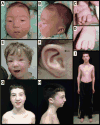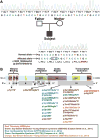An individual with blepharophimosis-ptosis-epicanthus inversus syndrome (BPES) and additional features expands the phenotype associated with mutations in KAT6B
- PMID: 24458743
- PMCID: PMC4414115
- DOI: 10.1002/ajmg.a.36379
An individual with blepharophimosis-ptosis-epicanthus inversus syndrome (BPES) and additional features expands the phenotype associated with mutations in KAT6B
Abstract
Blepharophimosis-ptosis-epicanthus inversus syndrome (BPES) is an autosomal dominant disorder caused by mutations in FOXL2. We identified an individual with BPES and additional phenotypic features who did not have a FOXL2 mutation. We used whole exome sequencing to identify a de novo mutation in KAT6B (lysine acetyltransferase 6B) in this individual. The mutation was a 2-bp insertion leading to a frameshift which resulted in a premature stop codon. The resulting truncated protein does not have the C-terminal serine/methionine transcription activation domain necessary for interaction with other transcriptional and epigenetic regulators. This mutation likely has a dominant-negative or gain-of-function effect, similar to those observed in other genetic disorders resulting from KAT6B mutations, including Say-Barber-Biesecker-Young-Simpson (SBBYSS) and genitopatellar syndrome (GTPTS). Thus, our subject's phenotype broadens the spectrum of clinical findings associated with mutations in KAT6B. Furthermore, our results suggest that individuals with BPES without a FOXL2 mutation should be tested for KAT6B mutations. The transcriptional and epigenetic regulation mediated by KAT6B appears crucial to early developmental processes, which when perturbed can lead to a wide spectrum of phenotypic outcomes.
Keywords: BPES; KAT6B; blepharophimosis; epicanthus inversus; ptosis; whole exome sequencing.
© 2014 Wiley Periodicals, Inc.
Conflict of interest statement
None of the authors has any conflict of interest to disclose.
Figures


Similar articles
-
Clinical characterization and identification of five novel FOXL2 pathogenic variants in a cohort of 12 Mexican subjects with the syndrome of blepharophimosis-ptosis-epicanthus inversus.Gene. 2019 Jul 20;706:62-68. doi: 10.1016/j.gene.2019.04.073. Epub 2019 Apr 29. Gene. 2019. PMID: 31048069
-
Functional analysis of a novel FOXL2 mutation in blepharophimosis, ptosis, and epicanthus inversus syndrome type II and elucidation of the genotype-phenotype correlation.Hum Genomics. 2025 Apr 18;19(1):41. doi: 10.1186/s40246-025-00752-7. Hum Genomics. 2025. PMID: 40251640 Free PMC article.
-
Functional Analysis of a Novel FOXL2 Indel Mutation in Chinese Families with Blepharophimosis-Ptosis-Epicanthus Inversus Syndrome Type I.Int J Biol Sci. 2017 Jul 18;13(8):1019-1028. doi: 10.7150/ijbs.19532. eCollection 2017. Int J Biol Sci. 2017. PMID: 28924383 Free PMC article.
-
The Genetic and Clinical Features of FOXL2-Related Blepharophimosis, Ptosis and Epicanthus Inversus Syndrome.Genes (Basel). 2021 Mar 4;12(3):364. doi: 10.3390/genes12030364. Genes (Basel). 2021. PMID: 33806295 Free PMC article. Review.
-
Phenotypic Characterization of Seven Pediatric Patients Diagnosed With KAT6B -Related Disorders: Case Series and Review of the Literature.Am J Med Genet A. 2025 Sep;197(9):e64100. doi: 10.1002/ajmg.a.64100. Epub 2025 Apr 25. Am J Med Genet A. 2025. PMID: 40277451 Review.
Cited by
-
The lysine acetyltransferase activator Brpf1 governs dentate gyrus development through neural stem cells and progenitors.PLoS Genet. 2015 Mar 10;11(3):e1005034. doi: 10.1371/journal.pgen.1005034. eCollection 2015 Mar. PLoS Genet. 2015. PMID: 25757017 Free PMC article.
-
The necessity for in vivo functional analysis in human medical genetics.Med Res Arch. 2015 Nov;2(8):10.18103/mra.v2i8.393. doi: 10.18103/mra.v2i8.393. Med Res Arch. 2015. PMID: 26989768 Free PMC article.
-
Mosaicism in BRPF1-Related Neurodevelopmental Disorder: Report of Two Sisters and Literature Review.Case Rep Genet. 2023 Nov 1;2023:1692422. doi: 10.1155/2023/1692422. eCollection 2023. Case Rep Genet. 2023. PMID: 37946714 Free PMC article.
-
The Chromatin Regulator BRPF3 Preferentially Activates the HBO1 Acetyltransferase but Is Dispensable for Mouse Development and Survival.J Biol Chem. 2016 Feb 5;291(6):2647-63. doi: 10.1074/jbc.M115.703041. Epub 2015 Dec 16. J Biol Chem. 2016. PMID: 26677226 Free PMC article.
-
Deficiency of the chromatin regulator BRPF1 causes abnormal brain development.J Biol Chem. 2015 Mar 13;290(11):7114-29. doi: 10.1074/jbc.M114.635250. Epub 2015 Jan 7. J Biol Chem. 2015. PMID: 25568313 Free PMC article.
References
-
- Basel-Vanagaite L, Dallapiccola B, Ramirez-Solis R, Segref A, Thiele H, Edwards A, Arends MJ, Miró X, White JK, Désir J, Abramowicz M, Dentici ML, Lepri F, Hofmann K, Har-Zahav A, Ryder E, Karp NA, Estabel J, Gerdin AKB, Podrini C, Ingham NJ, Altmüller J, Nürnberg G, Frommolt P, Abdelhak S, Pasmanik-Chor M, Konen O, Kelley RI, Shohat M, Nürnberg P, Flint J, Steel KP, Hoppe T, Kubisch C, Adams DJ, Borck G. Deficiency for the ubiquitin ligase UBE3B in a blepharophimosis-ptosis-intellectual-disability syndrome. Am J Hum Genet. 2012;91:998–1010. - PMC - PubMed
-
- Beysen D, Raes J, Leroy BP, Lucassen A, Yates JRW, Clayton-Smith J, Ilyina H, Brooks SS, Christin-Maitre S, Fellous M, Fryns JP, Kim JR, Lapunzina P, Lemyre E, Meire F, Messiaen LM, Oley C, Splitt M, Thomson J, Van de Peer Y, Veitia RA, De Paepe A, De Baere E. Deletions involving long-range conserved nongenic sequences upstream and downstream of FOXL2 as a novel disease-causing mechanism in blepharophimosis syndrome. Am J Hum Genet. 2005;77:205–218. - PMC - PubMed
-
- Beysen D, De Paepe A, De Baere E. FOXL2 mutations and genomic rearrangements in BPES. Hum Mutat. 2009;30:158–169. - PubMed
-
- Campeau PM, Kim JC, Lu JT, Schwartzentruber JA, Abdul-Rahman OA, Schlaubitz S, Murdock DM, Jiang M-M, Lammer EJ, Enns GM, Rhead WJ, Rowland J, Robertson SP, Cormier-Daire V, Bainbridge MN, Yang XJ, Gingras MC, Gibbs RA, Rosenblatt DS, Majewski J, Lee BH. Mutations in KAT6B, encoding a histone acetyltransferase, cause Genitopatellar syndrome. Am J Hum Genet. 2012;90:282–289. - PMC - PubMed
-
- Champagne N, Bertos NR, Pelletier N, Wang AH, Vezmar M, Yang Y, Heng HH, Yang XJ. Identification of a human histone acetyltransferase related to monocytic leukemia zinc finger protein. J Biol Chem. 1999;274:28528–28536. - PubMed
Publication types
MeSH terms
Substances
Supplementary concepts
Grants and funding
LinkOut - more resources
Full Text Sources
Other Literature Sources

